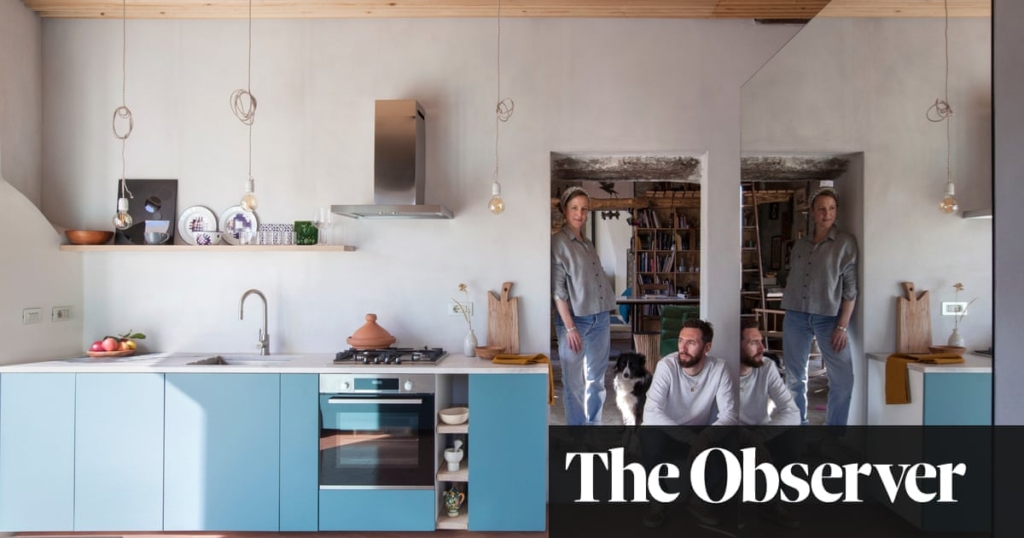Bu içerikte, İtalyan tasarımcı ve mimar Riccardo Monte’nin Alp dağları ve orman vadilerinden aldığı ilhamla yaşadığı eski bir ahırda nasıl yaşadığı ve evini nasıl dönüştürdüğü anlatılmaktadır. Riccardo’nun ailesiyle birlikte yaşadığı bu evdeki dönüşüm süreci, ahşap mobilyalar, tasarımlar ve doğal malzemelerin nasıl kullanıldığı üzerinde durulmaktadır. Ayrıca evdeki odaların nasıl birbiriyle bağlantılı hale getirildiği ve modern dokunuşların nasıl yer aldığı da detaylı bir şekilde anlatılmaktadır. Evin iç ve dış tasarımı, aile yaşamı ve doğal malzemelerle çalışmanın önemi vurgulanmaktadır.
Kaynak: www.theguardian.com
Sheer Alpine mountains and forested valleys are both neighbour and inspiration for Italian designer and architect Riccardo Monte. His home, a 250-year-old former animal shed, is tucked into a tiny Italian village in the Ossola valley, not far from the Swiss border and Lake Maggiore.
Riccardo lives with his English partner, photographer and filmmaker Katie May, their six-year-old son, Julian, and collie, Lupa. The couple met in London more than a decade ago when their paths crossed in Hackney’s Dolphin pub. But they left a few years later, burned out by the frenetic pace of the metropolis, for a slower pace of life in Riccardo’s home county.
“In Italy we say tabula rasa, which literally means a clean slate, My time in the city was over, I wanted a restart, less pressure, more countryside,” says Riccardo, who began his new chapter drawing the mountains with charcoal, before picking up hefty trunks of local pine and cedar to craft furniture. He finishes each piece using a timber-charring technique learned from his neighbours, who char the wooden bases of grapevine frames to deter insects and prevent rot, a process similar to the Japanese method of timber preservation called shou sugi ban.
“I was experimenting; here, you either work with wood, marble or stone. Having made wooden architectural models for years at work, I was instinctively drawn to wood.”
His work is scattered through the house. The robust spruce Casetta stools next to the dining table and wide cedar-wood side tables charred by fire are decorated with deep grooves or simply left with natural grains and knots.
Riccardo grew up in the rooms above what is now his home, a 1770 stone and timber mountain house, where his mother and 93-year-old grandmother still live. Traditionally, the ground floor was used as stables, a tool shed and kitchen, where the family would distil grappa and cook in the hot summers.
Despite centuries of grime, mouse nests and rusting machinery, Riccardo saw a home for his family on this floor and the conversion began. First, he linked what were three separate spaces by creating door-shaped holes consecutively between each. “We designed it so that the openings connected visually. There is a beauty in being able to look through from one room to the other, a sense of flow. You can stand in the kitchen and see the fire in the stove in the bedroom.”
The first room in the sequence is now the family bedroom, which his grandfather, who was an architect, used as a studio in the 1950s. They removed the old fireplace, added a wood-burning stove, insulation and thick spruce floorboards. They kept the exposed beams and dense stone walls, some of which had been plastered by Riccardo’s father, repainting the plaster and placing the family crib there. Several generations of his family have taken their first snooze in this humble wicker cot, as did Julian.
Rough, textured concrete applied in the 1950s was left on the walls in the main living space, once the stable, today their studio and living room, which unfolds from the bedroom. The original stone flags and even the hot and cold water pipes that supply his mother and grandmother’s bathroom, were left exposed. “I didn’t want to cover anything, he says. “Everything is visible, I wanted to keep it as close to how it was before.”
They fixed broken floor tiles, insulated the ceiling, adding wooden spruce battens to help with acoustics, built shelving from chipboard and a mezzanine space above using old spruce planks and a beam of chestnut that Riccardo found in the forest. A woodblock print of a crow by Elisabeth Bond, bought in a London gallery, sits alongside an old cow bell, a gift from their elderly neighbour.
Their home still has exterior entrances to each room, so the bright Alpine light floods inside. Riccardo created a new glazed steel door into the living room, the curved shape copied from the original 150-year-old timber door, whose wide arches were designed for a horse and cart, still open behind the new entrance. Black coils of industrial lighting cable unfold down the walls, framing the kitchen doorway, while one of Riccardo’s Alpine charcoal artworks hangs above.
Soft blue kitchen cabinets, with carcasses from Ikea and doors made by Ricardo, and handmade Sicilian tiles by Tomasello give a contemporary edge to the kitchen. “We wanted more of a Mediterranean feel in here,” says Katie. Mining for marble is common in these parts, the village boasts two caves: one provided pink marble for the Milanese Duomo while the other extracts marble with a rich black lava stratum that they have used on the countertops.
Reflecting the sky and Riccardo’s handmade timber benches outside, the family bathroom is hidden in plain sight using a vast mirrored square suspended in the kitchen. Riccardo designed the room as a reflective cube that appears to fade into the room. “We had to fit the bathroom into this room, and I didn’t want to put it in the corner, or see doors, so I designed it with space around it, and mirrored the front so it feels unattached and freestanding.”
The sensitive conversion of the lower floor has altered the flow of this historic building into an ancient modern iteration of an open plan family home. “There is a poetry to life here,” muses Katie. “The community, multiple generations and sense of family is a beautiful thing.”
“Taking a leap into doing something creative so we can put food on the table, the wood, the imperfections, we celebrate that,” says Riccardo.





Yorumlar kapalı.